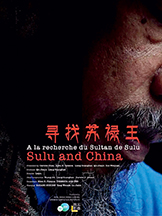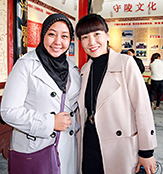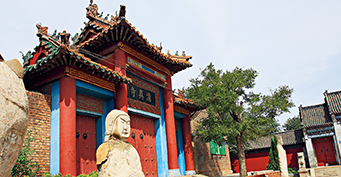“I discovered that I was a descendant of Paduka Pahala at a very young age,” recounted An Jing, a 19th-generation descendant of the traveler from what is now the southern Philippines. Tradition holds that Pahala’s family remained in China after his demise. An serves as director of publicity at Dezhou Sulu Culture Museum in eastern China’s Shandong Province. “It’s my duty to protect the tomb of the king of Sulu and preserve his deep feelings about China.”
The ruler from the ancient kingdom of Sulu has rested in China for more than 600 years, leaving a testament to the timelessness of China-Philippines friendship. Twenty-two generations of his family have protected the tomb as a source of spiritual sustenance and a historical witness of friendship between the two countries.
‘Head-of-State Diplomacy’ in History
Sulu was an ancient Muslim emirate that ruled the Sulu Archipelago of the southwestern Philippines. Over 600 years ago, Chinese navigator Zheng He made three visits to Manila Bay, Visayas and Sulu during his voyages to the Western Seas. Historical records show that China had had contact with the Philippines as early as the 3rd Century. Economic, trade and cultural exchanges between the two countries became very active in the Tang, Song and Yuan dynasties (618-1368).
In 1417, 12 years after Zheng He’s first voyage to the Western Seas, Sulu East King Paduka Pahala, alongside two other rulers known as “West King” and “Cave King,” respectively, led a 340-strong high-level delegation including senior officials, family and close relatives on a voyage across the seas to pay tribute to Yongle, the third emperor of the Ming Dynasty who reigned from 1403 to 1424, opening a historical chapter of “head-of-state diplomacy.” Emperor Yongle hosted a grand state banquet and exchanged gifts with the king. The delegation was one of the largest foreign delegations ever hosted by the Ming court.
King Paduka Pahala and his entourage stayed in Beijing for 27 days and reached consensus with Emperor Yongle to promote friendship for generations to come before sailing on the Grand Canal from Beijing to Hangzhou towards home. Upon arrival in Dezhou, however, the king fell seriously ill and quickly died from an unknown disease. He was buried there with a luxuriant royal funeral and full honors for a foreign ruler. Emperor Yongle personally wrote the inscriptions on his tombstone. The king’s eldest son returned to Sulu to succeed him on the throne while two other sons and some family members stayed in Dezhou. His second son married with a local Muslim woman. Their descendants have since thrived in a village known as Beiying in Dezhou.
“Across multiple dynasties, the Chinese government has taken good care of the tomb of Sulu East King as well as his descendants,” commented An. During the reign of Yongzheng (1722-1735), the fifth emperor of the Qing Dynasty, another ruler of Sulu visited China and requested that the Qing court grant the descendants of the East King Chinese citizenship and give them the Chinese surnames Wen and An (the first names of the king’s second son Won Hala and third son An Doulu who stayed in Dezhou). Pahala’s descendants married local Muslim Hui villagers in Beiying, a village with distinct cultural heritage and tradition.
Over the last 600 years, more than 5,000 descendants living around China have been traced to the kingdom of Sulu.
Recent Exchange of Visits
Over the last 45 years of diplomatic relations, Philippine diplomats, members of the Sulu royal family, officials of Sulu Province and Philippine tourists have visited Dezhou to pay respect to the East King of Sulu. In June 2005, some Dezhou descendants of Paduka Pahala visited Sulu Archipelago to search for their roots. They were warmly welcomed by their relatives there. Gloria Macapagal Arroyo, then president of the Philippines, had a cordial meeting with them.
In 2013, Princess Miriam Donau Kilam, a descendant of Paduka Pahala in the Philippines, made a pilgrimage to the final resting place of the former king of Sulu. “The Princess was quite emotional upon seeing her ancestor’s tomb,” recalled An. “She prayed and moved slowly around the tomb to soak up all the details.” The princess has made three such visits and returned with a wealth of relevant information.
An hosts visits to the tomb by relatives from the Philippines every year. She has been impressed with each visit and stayed in touch with relatives.
Upon an invitation from Chinese President Xi Jinping, Philippine President Rodrigo Roa Duterte visited China from October 18 to 21, 2016. A joint statement between the two governments noted that “2017 marks 600 years of friendly contacts between the Sultanate of Sulu and China, and the Philippines and China expressed interest in holding relevant commemorative activities.”
A year later, An and some other representatives of Pahala’s descendants in Dezhou visited the Philippines to attend activities in commemoration of the 42nd anniversary of bilateral diplomatic relations and the 600th anniversary of the Sulu king’s journey to China.
“Fraternal bonds connect the people of our two countries,” declared An. “We should cherish this chapter of history and turn the page on a new chapter of friendly relations between the two countries.”
Pop Culture Legend
“The king of Sulu remains in the hearts of the people,” commented Liang Guanghan, Chinese dean of the Confucius Institute at Ateneo de Manila University since 2015.
Liang agreed with her Philippine counterpart that it is important for youth to develop a good understanding of the history of friendly relations between the two countries. They also agreed that a documentary on the king of Sulu would help in this regard.
“I specialize in new media communication and have some experience in film and television production,” noted Liang. “The idea of a documentary triggered my memory. In 1986, more than 30 years ago, China and the Philippines jointly produced a historical film titled The Sulu King & The Chinese Emperor which reconstructed the king’s historic visit to China. With modern film and VR technology, we could recreate this precious and beautiful chapter of history in a more popular form with better academic value.”
On the first day of the Chinese Lunar New Year in 2016, Liang had a phone conversation with Qiu Jiaqiu, then director of Caixin Video, a branch of China’s financial media group Caixin Media, to describe her ideas for a documentary. They agreed on the plan and began filming the king’s tomb during Spring Festival 2016.
It took more than three years to complete the production of the documentary on Pahala’s visit to China 600 years ago. The film features his descendants in China and traces the friendly relations between China and the Philippines. In August 2019, Sulu and China premiered at Ateneo de Manila University, which attracted a lot of attention in both countries. It was also shortlisted for the Paris Art Film Festival.
Darwin J. Absari, professor of history at the National University of the Philippines, served as chief narrator for the film. He believes that Sulu culture is the result of convergence with Chinese culture and the preservation of Chinese culture in Sulu. He hopes that the young generation can develop a better understanding of this period of history and keep it in their hearts. He also hopes that similar stories can be told properly.
“What opportunities will the changes in the relations between our two countries bring to the descendants of the king of Sulu?” asked Qiu. “Will there be collisions and resonance of seeking a common identity?” With the questions in mind, Qiu and his team are preparing to produce further documentary footage on Sulu and China.

Poster for the documentary film Sulu and China.

Sulu Princess Jacel Kiram (left) poses with An Jing, a 19th-generation descendant of Sulu East King Paduka Pahala living in Dezhou, eastern China’s Shandong Province.

The mosque at the Cemetery of the King of Sulu in Dezhou, Shandong Province.


 Copy Reference
Copy Reference